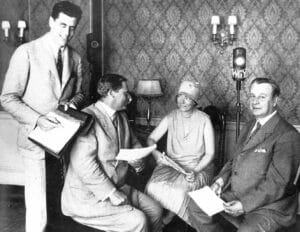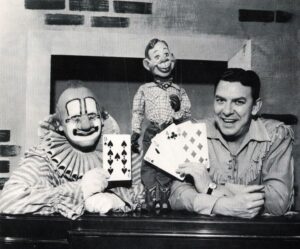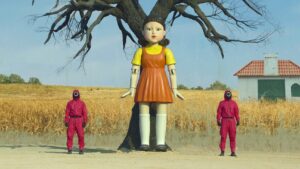Since its humble beginnings, television has come a long way, evolving from black-and-white broadcasts to binge-worthy streaming sensations. But where did it all begin? What was the very first TV show—and how did we get from there to the golden ages, reality TV booms, and global streaming hits of today?
In this timeline, we’ll explore the key milestones that shaped television history, from the first flickering images to the cultural powerhouses that define the medium now. Whether you’re a casual viewer or a true TV buff, this journey through the decades will give you a deeper appreciation for how far the small screen has come.
The Roaring 20s: Introduction of the First TV Show, The Queen’s Messenger

The Roaring Twenties were marked by flapper girls, speakeasies, and liberation, but something else marked the end of the decade: the production and release of the first TV show. The Queen’s Messenger by J. Harley Manners was a 20-minute drama about a royal messenger. It was the first TV show and aired on WGY radio station in Schenectady, New York, on September 11, 1928. Intended for screens no larger than a postage stamp, The Queen’s Messenger set the stage for TV shows and their rising fame throughout the 20th century. This broadcast introduced theatre-style storytelling to a new medium of television, opening the door for the future of TV shows.
In 1931, The Television Ghost, produced by the BBC, was the first supernatural TV show to share ghost stories and paranormal experiences. Throughout this decade, radio was still a popular form of entertainment, especially with President Roosevelt’s fireside chats, which he used to talk about public concerns in an informal and relaxed setting. However, as World War II came to an end, the economy began to grow, and television sets became more common in American households, setting the stage for the Golden Age of Television.
1940s–1960s: The Golden Age of Television
On July 1, 1941, the first television commercial aired during a Brooklyn Dodgers–Philadelphia Phillies game, broadcast to the roughly 4,000 homes that owned a TV set at the time. By 1960, that number had skyrocketed to 45.7 million, with 90% of households owning a TV, paving the way for what’s now known as the Golden Age of Television. Starting in the late 1940s and extending into the early 1960s, the Golden Age of Television introduced the first sitcom ever made, the arrival of televised game shows, and the rapid expansion of news broadcasts.
In 1946, the UK produced the first ever sitcom, Pinwright’s Progress, and the US followed closely behind, airing Mary Kay and Johnny in 1947. BBC came out with the first TV kids’ show, Children’s Hour, in 1946. It was originally a radio show that had been on air since 1922, but with the growth of TV sets, the producers decided to bring it to life visually, bringing delight and entertainment to kids for many years. Kukla, Fran, and Ollie, a puppet show for children, started airing in the US in 1947. In the same year, Howdy Doody debuted and charmed children with the famous puppet and Clarabell the clown. Meet the Press, an American news program featuring political commentators and Capitol Hill policymakers, also premiered that same year, and it holds the title of the longest-running television show in U.S. history.
The following year, TV introduced the “variety show” format involving various acts, including comedy skits, musical performances, dance routines, and dramatic presentations. Texaco Star Theater, hosted by Milton Berle, and Toast of the Town, hosted by Ed Sullivan, were two variety shows that aired in 1948 and quickly took TV by storm. Berle would soon become known as “Mr. Television” due to his charisma and charm on the screen.
Throughout the 1950s, many notorious and groundbreaking shows debuted on TV. In 1950, Crusader Rabbit became the first animated TV show to debut. On September 4, 1951, the first national live television broadcast took place when President Harry Truman’s speech at the Japanese Peace Treaty Conference was transmitted via AT&T’s transcontinental cable and microwave relay system to regional broadcast stations nationwide. In the same year, I Love Lucy premiered, laying the groundwork for future TV series. Produced on film, with a multi-camera setup and live audience, I Love Lucy drastically differed from its predecessors. It also pushed Lucille Ball into the spotlight, making her television’s first major female star. In January of 1952, The Today Show became the US’s first broadcast morning news program, which still runs live today. 1955’s The $64,000 Question started the Game Show craze on television, with similar shows following its path, including Nothing But the Truth, Twenty-One, and Can Do.
TV in the 1960s was marked by politics and breaking news. In 1960, the first-ever televised presidential debate occurred between John F. Kennedy and Richard M. Nixon, with an estimated 60–70 million viewers. By 1963, more Americans were getting their news from television broadcasts than from newspapers. That same year, the November assassination of President John F. Kennedy pushed TV into the spotlight like never before, with the entire nation on the edge of their seats for four days watching the screens. During this tumultuous time, the first televised murder happened as Jack Ruby shot Lee Harvey Oswald as he was being transferred from the Dallas city jail.
Nearing the end of the Golden Age of Television, the first Super Bowl was broadcast live in 1967 as millions watched the Green Bay Packers take down the Kansas City Chiefs, 35-10. Amidst the protests of the Vietnam War and the civil rights movement, a now-famous kids’ show debuted in 1969: Sesame Street. Intending to reach inner city children of color who lacked similar educational opportunities as white kids in the suburbs, the producers rolled out an, at the time, radical TV show that featured a diverse cast, educational content rooted in research, and a welcoming neighborhood feel—thus, Sesame Street was born. It would run for 55 years, featuring famous guest stars such as Robin Williams, Destiny’s Child, Tina Fey, and Ray Charles.
Closing Out the 20th Century: Nostalgic Sitcoms and Kid-Focused Channels
Several memorable TV shows emerged near the end of the 20th century, including more kids’ shows, sitcoms, dramas, and action series. In 1977, Nickelodeon became the first TV channel solely devoted to kids, debuting shows like Pinwheel, Video Comic Book, and America Goes Bananaz. During this time, cable television became the norm, eating into the Big Three networks’ (ABC, CBS, NBC) share of the viewing audience.
News broadcasts also started to shift in the 1980s, no longer offering only hour-long daily segments. CNN became the first network to offer 24/7 coverage of news and popular events, leading to a significant bump in viewership in its coverage of the Gulf War. This action would inspire their competitors down the road, when Fox News and MSNBC launched in 1996, providing ongoing news coverage.
The 1990s saw a surge in sitcoms, medical series, and crime shows, including Seinfeld, Friends, ER, and Law & Order. However, the TV show landscape was soon to see a major change due to the rise of reality television, the expansion of cable networks, and the early impact of the internet—factors that began to shift audience preferences and fragment the once-dominant prime-time model.
The 2000s: The Rise of Reality TV & Streaming Platforms
While the first reality TV show was Candid Camera in 1948, this form of television didn’t gain traction until the early 2000s. At the start of the 21st century, reality TV shows quickly gained traction and became a cultural phenomenon, providing unscripted, cheap, and extremely popular entertainment. Series like Survivor (2000–present), American Idol (2002–2016, revived in 2018), and The Bachelor (2002–present) took television by storm, gaining millions of viewers and increasing engagement. These shows set the stage for the reality TV boom of the 2000s and beyond, paving the way for everything from competitive formats like The Voice and Top Chef to drama-filled docu-series like Keeping Up with the Kardashians and Real Housewives. Reality TV became a cultural phenomenon, influencing fashion, language, and even celebrity culture.
The most significant change in the last couple of decades is the rise of streaming platforms. Once a DVD rental service, Netflix started offering streaming services in 2007, allowing subscribers to access content directly over the Internet. In 2013, the platform shifted its game by producing original content, with the first Netflix-produced TV shows, including House of Cards and Orange is the New Black, proving it could compete with major networks. Netflix now boasts over 3,600 original titles, including pop culture juggernauts like Stranger Things and Squid Game—the latter of which not only captivated global audiences but also propelled South Korean culture further into the international spotlight. Other streaming platforms, including Hulu, Disney+, Amazon Prime, and more, have significantly impacted traditional television. Instead of conventional scheduling, viewers can now control what, when, and how they watch—often binge-watching shows and avoiding ads.
Not only have TV shows changed in how they’re delivered, but also in their production value. Today, shows often feel like movies, attracting top film talent and delivering cinematic visuals. Game of Thrones, airing its first episode in 2011, had a blockbuster-level budget and epic storytelling, raising the bar for what TV shows could look like. The Last of Us, which premiered in 2023, is a critically acclaimed video game adaptation with high-end production, character depth, and mainstream appeal, further shaping the future of TV series.
Make Your TV Show With Avalanche Studios
So, where are TV shows headed? With technology moving fast and viewers craving fresh, authentic stories, we’re likely to see more boundary-pushing content, greater diversity on screen, and maybe even shows shaped by real-time audience input. One thing’s for sure—it won’t be boring.
If you’re ready to shape the future of television and create a series that resonates with audiences long after the final episode airs, Avalanche Studios is here to help bring your vision to life. We provide comprehensive video production services, from script-writing to post-production. Partner with our award-winning creative team to create a show that wins awards and sets the stage for the future of TV. Request a quote to get started!





Recent Comments